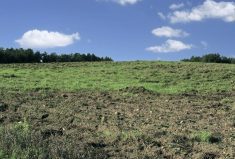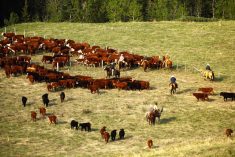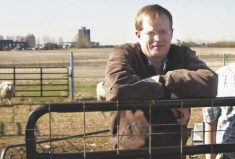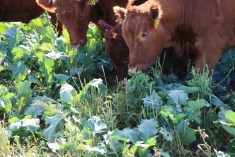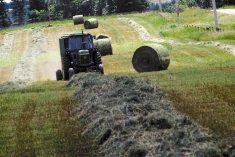July is the most difficult time for figuring out the price of hay, and this year is no exception, says provincial farm business management specialist Ted Nibourg.
“Two long hard winters back to back reduced much of the hay carry-over in the province,” says Nibourg. “There were numerous reports of strong hay prices earlier this spring. These were typically paid by producers who had run out of feed and pastures were not growing. As well, some cattle were turned out to pasture earlier than normal. This may increase the demand as these producers could find themselves starting to feed earlier than anticipated.”
Read Also

Hail research hopes to benefit potato growers
Alberta research scientist measures hail storm and heat dome affects on potato crops
It will likely be October — when everyone has a good handle on this year’s forage production and the number of calves being backgrounded — before prices settle.
But producers can still put a value on a standing hay crop — which is the estimated market value of hay in the bale less cutting and baling costs plus an allowance for weather risk.
- More from the Alberta Farmer Express: Most Saskatchewan crops in fair to excellent condition
“The weather risk allowance would be at least 10 per cent (for example, grass hay) and as high as 30 per cent (for example, alfalfa) of the expected market value,” says Nibourg. “Without it, a badly weather-damaged crop could cost the producer the same amount as if they had purchased ready-made, top-quality bales from someone else.”
Alberta Agriculture and Rural Development’s custom rates survey summary outlines the current rates being charged for most custom haying operations. Producers can also use the online machinery cost calculator on Ropin’ the Web to determine those costs for their operation.
“Many Alberta producers include the asking prices in their hay for sale listings on our Alberta Hay and Pasture Directory,” says Nibourg. “As well, Agriculture Financial Services Corporation publishes historical forage price data for all regions of the province.”
A typical scenario for two parties entering into a standing hay agreement is to arrive at a best guess for both price and yield and from that, estimate the value of the standing hay crop. The tenant would then pay one-half of that value at haying time and then make a final payment, either more or less, in the fall.
“A crop share is another simple but effective rental arrangement for a forage crop,” says Nibourg. “The tenant harvests the crop and gives the landlord their share of the crop in bales. The landlord then has a product that is ready for sale or for their own use. With this year’s higher-valued hay crop compared to the past few years the landlord’s crop share for a hayfield can vary from 40 to 60 per cent.
“It is important that the estimated market value, yield potential, and harvest costs for the crop are considered to ensure that the arrangement is fair for both parties. Again, the final settlement is determined in late October when prices are more firmly established.”




